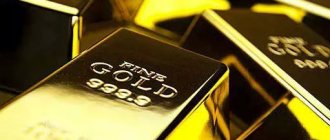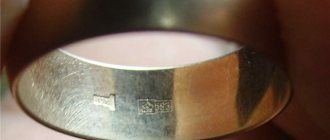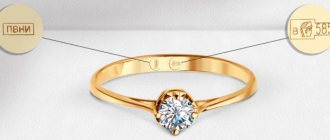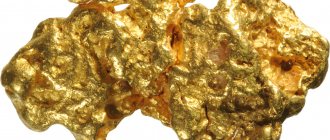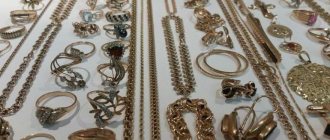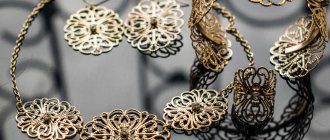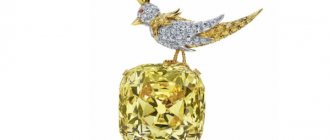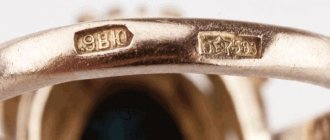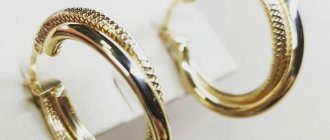Gold is perhaps the only metal that will never lose its popularity. For many centuries, this amazing precious metal has had an irresistible power over man.
Every year, jewelry designers and manufacturers set fashion trends in gold jewelry, including one or another shade of this precious metal. But gold is not just fashion, but, above all, a symbol of beauty and harmony.
Gold is the only metal that, in its pure form, has a bright yellow color. It is a soft, malleable, ductile and malleable metal. One of the most valuable properties of gold is its chemical resistance. That is why gold is the most “noble” of the entire group of precious metals. In addition, the shape and structure of gold molecules are unique: they can be plate-like, round, or needle-shaped.
Due to its beauty and ductility, gold is one of the main materials in jewelry production. Pure gold in jewelry serves as the basis for precious alloys and for gilding. When different metals are added, gold changes color from red to white. This allows jewelers to create products that can highlight the individuality of the owner and the sophistication of the gemstone.
Gold and its alloys
Gold alloys are classified according to color into white, red, yellow, green, pink and others. It is important to know that alloys of the same shade can be of different samples.
The characteristics that an alloy must have are determined by the participation of one or another component in its composition:
- To obtain white gold, platinum, palladium and nickel are added to the alloy. Such compositions have a high melting point and are almost resistant to corrosion.
- Copper and silver make it possible to create an alloy from light yellow to red shades, as well as to achieve greenish and reddish tones. Such products have an average melting point, maintaining the plasticity of the metal and high malleability.
- To obtain an alloy with a low melting point, gold is diluted with zinc and cadmium. Such alloys are often used as solders.
So, the following components can be added to gold:
- Copper. A bright red alloy can be obtained by achieving a copper content of 14.6%. It gives the composition hardness while maintaining its viscous properties. But copper makes the metal more susceptible to corrosion.
- Silver. A white alloy is obtained when it contains 65% argentum. With a silver ratio of 30%, the color will be white-yellow. When adding a small amount of silver, the composition will have a greenish tint.
- Platinum. Used to achieve a white alloy color. A white tint is obtained already at 8.4% platinum content. This metal also increases elasticity.
- Palladium. It is also used to obtain a white tint, but in this case it is necessary to add at least 10% of the substance to the alloy. The metal sharply increases its melting point, leaving its ductility unchanged.
- Nickel. Mainly affects the casting characteristics of the alloy, increasing its fluidity. The color of the composition changes to pale yellow. Nickel is a highly allergenic metal that can cause skin irritation when wearing jewelry for a long time.
- Zinc. Used to impart a slight greenish tint, significantly reducing the melting point. The presence of zinc in the product makes it more fragile.
Colors of gold alloys depending on composition
The color depends on the ratio of the components taken. Jewelry that looks the same can have different prices and properties thanks to extensive research in this area.
Yellow
The classic color is the result of a combination with Cu and Ag. Improves wear resistance. Yellow color in jewelry has been very popular for several centuries. 750 and 585 are typical gold content values for this color.
Black
A very effective color for modern jewelry, it can be obtained in several ways:
- oxidation with cobalt;
- during dressing with the addition of carbon;
- patting;
- Rhodium or ruthenium plating.
White
Color is obtained by adding a variety of ligatures. It can be manganese, nickel, or palladium. Jewelry of this color is very beautiful, white with a yellow undertone. They first began to produce it in the first decade of the 20th century to replace a refractory alloy with platinum.
Red
As a result of combining gold with copper, a pink or red alloy is obtained. This species spread throughout Europe in the 20th century. For Russia, its appearance dates back to the 18th century. Today it is popular as a base in engagement rings.
Other
Greenish-yellow is the result of fusion with a silver ligature. Consists of 73% gold and 27% silver. The name “electrum” came to us from Ancient history as a natural compound. A greenish tint is characteristic of alloys with the addition of cadmium. Jewelry made from such an alloy is considered harmful to health. Due to the toxicity of the ligature, they should not be worn for long periods of time.
When alloyed with indium, it produces a spectacular blue color.
For a long time, jewelers around the world tried to get purple gold. The experiments were successful in 2002. 19 carat (750 carat) purple gold contains additives of aluminum and palladium. It seems difficult to care for such products. The material is very fragile and is used in jewelry only as individual elements.
Gold samples
There are several established systems for determining metal samples. The most famous of them are metric and carat.
In Russia, the metric system for determining samples has been used for a long time, as it is very convenient and understandable. This system displays how much pure gold is contained in one kilogram of the alloy. For example, if 1000 grams contains 585 grams of gold and 415 grams of impurities (ligatures), the product will be 585 fine.
Each sample has its own characteristics and it is difficult to say which one is better. To store the precious metal in bullion, 999 purity is used, i.e. gold is stored in almost pure form. While the most common standard for creating jewelry is 585.
As for the karate rating system, it is most popular in Europe and the USA. In this case, 24 parts of the alloy act as the base, and the sample shows how many full parts are gold.
So, if a product has a hallmark of 18K, this means that it consists of three-quarters gold and a quarter alloy. In metric parlance, this is 750 sterling. Jewelry is made from the following alloys: 9 carat, 10, 14, 18 and 24.
958 sample
The composition of this sample includes 95.8% pure gold . It is as close as possible to the characteristics of red gold.
The hallmark corresponds to 23 carats in the karat grading system. 958 standard is extremely rarely used by jewelers to create jewelry. This is due to the prohibitively high cost of products and their susceptibility to various types of damage.
The composition of such an alloy, according to GOST 30649-99, in addition to the noble metal, may include the following components:
- Silver – 1.7-2.3%
- Copper – 1.2-2.4%
- Iron – up to 0.08%
- Lead – up to 0.003%
- Antimony – up to 0.003%
The alloy has a bright yellow color with a characteristic shine. It is used only to create some parts of products that are not subject to continuous physical impact.
958 standard is not sold in the form of bars and is sold only as scrap or jewelry. The cost of the alloy is variable and depends on various factors, such as the place of production, the complexity of the work, the place where the product was purchased, etc.
Alloy 958 has not found wide use despite the fact that it is approved by GOST.
750 sample
This hallmark is very popular among jewelers and corresponds to 18 carats. It contains 75% gold, which is the most optimal ratio. How many grams are in 1 carat of gold can be found here.
A fairly high percentage of gold attracts buyers, and it is easy for craftsmen to work with this composition, since it also contains enough ligature (25%). 18k gold is easy to polish and process.
The color of a gold product of this standard varies depending on what constitutes the remaining 25%.
The most common option is white products, for which palladium and silver are used in a ratio of 20% to 5%. The uniqueness of such products lies in their external similarity to natural platinum, however, their cost is 40% cheaper than platinum jewelry.
585 sample
This test can easily be considered the most popular in jewelry making. Rings, cufflinks, chains, bracelets, buttons, family heirlooms, etc. are made from it. 585-karat items do not fade over time and are very durable.
What is added to 585 gold? The shades of gold of this standard can be very different: white, red, pink, green, etc. It depends on the composition of the impurities. The 585 gold alloy classically contains copper and silver.
585 sample has an interesting origin. It appeared after the collapse of the Soviet Union as a replacement for 583 gold, which was not particularly popular. Being isolated from European countries, the USSR itself set standards and tests. By increasing the gold content by 0.2%, the inventors obtained the famous 585 standard, which meets all the requirements of both consumers and jewelers.
500 and 375 sample
500 standard is extremely difficult to find on jewelry counters today due to a number of disadvantages of such an alloy.
Despite the fact that it is approved for making jewelry, almost no one uses it. This is due to the very low casting properties of this sample. It has found its application as a standard for the inspection of jewelry.
375 gold is also rarely found in jewelry stores. Products made from such an alloy quickly lose their attractiveness and shine, which is why the demand for them is extremely low. 375 standard is used in the manufacture of bracelets, cigarette cases, watches, and household items and interior elements are also inlaid with this alloy.
What impurities are added?
Different shades of 585 gold are created in different ways. For example, pink is obtained by adding copper. White gold, which can easily be confused with silver, is also made by adding copper and a small amount of silver. Unlike the latter metal, such gold is much stronger and more beautiful.
In addition to the above compounds, other alloys are added:
- Zinc.
- Nickel - along with copper, gives gold its hardness and resistance to corrosion.
- Palladium allows you to make delicate jewelry of the most incredible shapes.
- Platinum imparts a silvery color and increases the density of the finished product, extending its service life.
- Antimony increases fluidity and helps reduce the cost of production. It is added to Olympic medals: in fact, they contain only 1% of the precious metal.
Yellow gold
Most jewelers prefer to work with yellow gold, which is a unique material. It is quite durable, but at the same time easy to process.
Yellow gold allows you to depict the most elegant and subtle patterns. Pearls, precious and semi-precious stones go well with it.
What is added to yellow gold? Typically, silver and copper . The reasonable cost of these alloys makes yellow gold quite affordable in the price category.
Yellow gold is remarkable because it suits any skin tone. Moreover, it has the same value in all countries and continents. The price of such gold can vary quite widely and depends on many factors described above.
Cleaning yellow gold is quite easy: using hydrogen peroxide, salt and detergents.
BENDES studio jewelers tell why
In nature, gold is burdened with a number of impurities. Miners need to put in a lot of effort to extract valuable rock from the depths of the earth and rid the mineral of foreign inclusions. The resulting metal is formed into pure gold bars. In Russia, such gold is available for sale at Sberbank, and is called “bank bullion”. To be fair, it is worth noting that even here it is not entirely pure gold. The purity of the bank bullion is listed as 99.99%. This means that the quantitative content of Au (Aurum) per 1000 conventional parts is 999 parts. The remaining one part is the permissible error after cleaning the mined metal.
White gold
White gold typically contains platinum, silver, palladium and nickel . In terms of price, white gold will always be more expensive than yellow gold, which is associated with the cost of the alloy. You should be especially careful when handling products containing nickel, as this metal causes allergies and skin reactions in many people.
The ideal option is white gold with the addition of palladium and platinum, however, such an alloy can be difficult to find, and the prices for such products are extremely high. Often such jewelry is produced in a single copy or in limited quantities.
White gold jewelry must be plated with rhodium. Otherwise it will have a grayish tint. In addition, this coating protects the gold from microscopic damage.
The disadvantage of white gold is that the coating wears off over time and the product becomes dull. In this case, you need to take it to a jeweler to update the coating. White gold is very delicate and delicate: even chlorine contained in running water can harm it.
Alloy markings
Gold-containing alloys have a common marking. It is based on the designation in Cyrillic letters:
- Zl – gold;
- Pd – palladium;
- Pl – platinum;
- Kd – cadmium;
- Wed – silver;
- M – copper;
- N – nickel;
- C – zinc.
Next to the letters indicating the metal is a number indicating the percentage of the material contained. For precious metals, the content is indicated in fractions of a thousand, for the rest - in hundredths, that is, as a percentage.
Black gold
Black gold is extremely rare and its cost is high compared to other types of gold. It is obtained in several ways: by adding various alloys to the composition, or by spraying ferrous metal powder onto a gold item. Most of the recipes for making such gold are kept secret.
Black gold looks very impressive, rich and elegant. Jewelry made from it is suitable for both men and women. Compared to yellow gold, black gold is more fragile, but, without a doubt, more valuable and expensive.
Why do you need a ligature and is it possible to do without it?
In the jewelry industry, the alloy for gold is extremely important - by adding various elements to the alloy, you can achieve significant changes in the characteristics of a gold product, such as strength or appearance. It should be taken into account that only pure metals are used as an additional element, without any impurities. This does not mean that gold can only be mixed with one specific element; the combination of several metals is allowed and quite successfully used. Pure gold is a rather soft and very ductile metal, and such jewelry made from it will be quite difficult to wear without worrying about its safety. This is why a ligature is used - by adding other elements to it, it becomes possible to significantly increase the strength of the product.
Other colors
Modern technologies make it possible to create gold alloys of almost any shade, but not all of them have sufficient characteristics to enter the wide market. So, there are several technologies for inventing purple gold. But such products are not always practical.
In Uralsk, scientists at the Physical Institute of Metals have come up with a way to create green, purple, blue, violet and black gold.
In addition, scientists have discovered the fact that when certain conditions are compared, the surface of gold can acquire different shades. By experimenting with yellow gold, it was possible to achieve a deep blue tint of the alloy.
Why is the decoration yellow or white in one test?
The white tint of the product is due to the presence of the following metals: platinum, palladium or silver in the alloy. The most expensive alloy is mixed with platinum - not all consumers can afford such jewelry. Compositions with nickel are more accessible, and they can be identified by their less bright shine, vaguely reminiscent of jewelry silver. But it is worth knowing that products made from this alloy negatively affect the health of the owner, often causing allergies. Adding only 1/10 of platinum often gives the composition shine and a distinctive white color, significantly increasing strength and increasing the material’s resistance to chemical attack. 585 standard contains a little more than half of gold, the rest consists of silver or platinum, which ensures the white color of the product. Impurities of palladium or nickel give a barely noticeable yellowish tint. To obtain a pronounced white color, the composition is additionally coated with a layer of rhodium, an element belonging to the platinum group of metals, which gives the product high resistance to mechanical stress. The cost of this metal exceeds the cost of gold, and for this reason the value of such jewelry is comparable to the value of objects made of pure precious metal. Also, such decorations are absolutely harmless to health.
Methods for obtaining colored gold
There are several ways to obtain colored gold:
- Applying a special coating to the surface of the finished product. It is carried out due to the thermal and chemical reaction of metal alloys with the environment.
- Oxidation. This method involves creating decoration with artificial colors. An oxide layer is applied to the surface of the jewelry.
- Patination. In this case, chemical treatment of the alloy, which contains copper, occurs.
- Oxidation. Gold products are oxidized in air for 30-60 minutes at a temperature of 750-950 degrees Celsius. Thus, cobalt is used to obtain black gold.
- Rhodium plating. Application of rhodium plating on finished products.
- Galvanostegy. This method involves the use of solutions with the addition of special dyes that form a special layer on the jewelry and give it the desired color.
- Gold recoloring is the youngest, recently discovered method of obtaining colored gold. At the atomic level, gold is milled with an ion beam. The structure and depth are selected, light waves are controlled. Thanks to the ability of metals to absorb and reflect waves, any shade of gold can be obtained.
Thus, gold has been valued from time immemorial and is still considered a noble metal. A large selection of alloy compositions makes gold products accessible to people with different income levels.
Ways to decorate cakes and desserts
Applying edible foil to decorate desserts is scary, but not difficult. The easiest way is to use flakes. It is enough to scatter them on top of the cake or pastry in a chaotic order.
If you have small gold sparkles that you want to decorate chocolates or cakepops with, you can secure them with the icing that has not yet cooled, carefully sprinkling the dessert. As a result, you will end up with something like this:
A few more options for decorating chocolates:
The main thing is not to take the cereal with your hands. You can easily wrinkle them and leave greasy fingerprints on the surface. It's better to arm yourself with tweezers and save every piece.
How to attach gold leaf
Working with foil is a little more difficult than with flakes. If you are planning to cover a whole cake, you may not get it perfect the first time. Still, this is quite a painstaking job, for which you will need:
- fondant-covered cake;
- a bowl of water;
- book with foil;
- scissors;
- paper towel;
- gloves.
Operating procedure:
- Separate the paper sheet with foil from the book. Trim off excess paper on 3 sides. We will hold on to the last piece as we work.
- Fold the paper towel to form a tight, easy-to-work rectangle. Lightly moisten with water and blot the mastic. You need to process a small area at a time, a little larger than gold leaf. Do not wet the mastic too much, otherwise it will melt. We just blot it.
- Glue the gold leaf to the cake. To do this, apply the foil to the mastic and gently smooth it through the paper in one direction.
- We wet the adjacent area without touching the gold coating. Otherwise it will tear easily. Repeat the procedure until the cake is finished.
- If there are gaps left, cut the foil along with the paper to size and apply it carefully, trying not to catch the existing layer.
Gold leaf should not be touched with your hands, cloth or brush. It breaks and deforms very easily. And considering the cost of decor, every mistake will be expensive. But as a result you will get this beauty:
You also don't have to cover the entire cake. It is enough to make a beautiful pattern with the rim, without even worrying about making it even. This way, both you and the client will save money without losing the attractiveness of the decor:
Here is another simple idea for decorating a money cake. You can take chocolate coins and cover them with kandurin:
I love gold accents like these on desserts. And you? Or is it all just show-off and gypsyism? Share your opinion in the comments.
Chemical properties of the “king of metals”
The symbol Au is used to denote gold. This is an abbreviation for the Latin name for the metal - Aurum. In the periodic table of Mendeleev it is number 79 and is located in group 11. In appearance it is a yellow metal. Gold is in the same group with copper, silver and roentgenium, but its chemical properties are closer to the platinum group metals.
Inertness is a key property of this chemical element, which is possible due to the high value of the electrode potential. Under standard conditions, gold does not react with anything except mercury. With it, this chemical element forms an amalgam, which easily disintegrates when heated to just 750 degrees Celsius.
The chemical properties of the element are such that other compounds with it are also short-lived. This property is actively used in the extraction of precious metals. The reactivity of gold increases significantly only with intense heating. For example, it can be dissolved in chlorine or bromine water, an alcohol solution of iodine and, of course, in aqua regia - a mixture of hydrochloric and nitric acid in a certain proportion. The chemical formula for the reaction of such a compound is: 4HCl + HNO3 + Au = H (AuCl4) + NO + 2H2.
The chemistry of gold is such that when heated it can react with halogens. To form gold salts, this chemical element must be reduced from an acidic solution. In this case, the salts will not precipitate, but will dissolve into liquid, forming colloidal solutions of different colors.
Despite the fact that gold does not enter into active chemical reactions with substances, in everyday life you should not allow products made from it to interact with mercury, chlorine and iodine. Various household chemicals are also not the best companion for precious metal products.
The fact is that jewelry uses an alloy of gold with other metals, and various substances, interacting with these impurities, can cause irreparable damage to the beauty of the product. If you heat gold above 100 degrees Celsius, an oxide film one millionth of a millimeter thick will appear on its surface.
How to distinguish a fake?
There are several ways to distinguish a genuine product from a counterfeit. It should be noted that using only one test does not guarantee the accuracy of the result. It is better to check on several parameters. So, experienced jewelers use the following methods to distinguish gold from fake:
- Check softness. Real yellow metal is very soft. If you bite into it, it will leave a mark. This is exactly how you can spot a fake. Alloys with a minimum content of noble metal are hard.
- Check the sound. Real gold jewelry rings softly and easily. But you shouldn't rely on hearing alone. Different impurities distort the sound in different ways.
- They drip with iodine. If the product contains a large proportion of the desired metal, then a drop of iodine placed on the surface of the object will turn black. Otherwise, it will turn white.
- They draw on the tiles. Since the density of gold is higher than tile, it should leave a characteristic golden mark on it. If it is a fake, then the mark will remain on the product. Also, traces of gold dust will remain on the skin if the product is thoroughly rubbed, for example, on your hand.
- Weigh on special scales. If the metal density is less than declared, then the weight of the product will be less.
- Scrape the back of the object. This is done in order to find out whether ordinary copper or tungsten is hidden under a layer of gold.
Potential buyers should be wary of the following points:
- lack of documentation;
- discrepancy between the mark and the hallmark declared in the documents;
- corrections in documents;
- erased hallmark;
- hallmark of the Soviet period;
- unusual color of the product.
If something incomprehensible confuses you and there are any suspicions, this is a sure sign that you should first show the product to a professional, an appraiser or a pawnshop employee, and only then make a decision to purchase.


